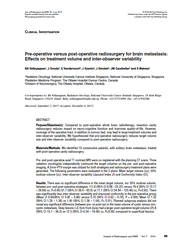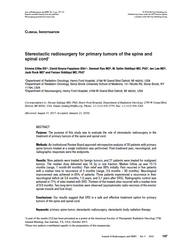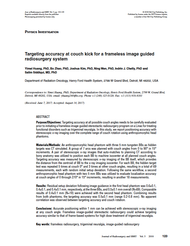- Home
- Journal Contents Downloads
- JRSBRT Downloads
- JRSBRT 5.2, p. 99-105
Product Description
Pain flare after stereotactic radiosurgery for spine metastases
Ehsan H. Balagamwala, Mihir Naik, Chandana A. Reddy, Lilyana Angelov, John H. Suh, Toufik Djemil, Anthony Magnelli and Samuel T. Chao
Purpose: Understanding of pain flare (PF) following spine stereotactic radiosurgery (sSRS) is lacking. This study sought to determine the incidence and risk factors associated with PF following single fraction sSRS.
Materials/methods: An IRB-approved database was compiled to include patients who underwent sSRS. Patient and disease characteristics as well as treatment and dosimetric details were collected retrospectively. Pain relief post-sSRS was prospectively collected using the Brief Pain Inventory (BPI). These factors were correlated to the development of PF (defined as an increase in pain within 7 days of treatment which resolved with steroids). Survival was calculated using Kaplan-Meier analysis and logistic regression was utilized to evaluate the association between the clinical and treatment factors and occurrence of PF.
Results: A total of 348 patients with 507 treatments were included. Median age and prescription dose were 59 years and 15 Gy (range: 7-18), respectively, and 62% of patients were male. Renal cell carcinoma (24%), lung cancer (14%), and breast cancer (11%) were the most common histologies, and 74% had epidural disease and 43% had thecal sac compression. The most common location of metastases was in the cervical/thoracic spine (59%), followed by lumbar spine (32%), and sacral spine (9%). Most common reason for treatment was pain (73%), followed by pain and neurological deficit (13%), asymptomatic disease (10%), and neurologic deficit only (3%). Median time to pain relief was 1.8 months. Median overall survival, time to radiographic failure, and time to pain progression were 13.6 months, 26.5 months, and 56.6 months, respectively. Only 14.4% of treatments resulted in the development of PF. Univariate analysis showed that higher Karnofsky performance score (KPS) (OR=1.03, p=0.03), female gender (OR=1.80, p=0.02), higher prescription dose (OR=1.30, p=0.008), and tumor location of cervical/thoracic spine vs lumbar spine (OR=1.81, p=0.047) were predictors for the development of PF. On multivariate analysis, higher consult KPS (OR=1.03, p=0.04), female gender (OR=1.93, p=0.01), higher prescription dose (OR=1.27, p=0.02), and tumor location of cervical/thoracic spine vs lumbar spine (OR=1.81, p=0.05) remained predictors of PF. No other dosimetric parameters were associated with the development of PF.
Conclusion: PF is an infrequent complication of sSRS. Predictors for the development of PF include higher consult KPS, female gender, higher prescription dose, and cervical/thoracic tumor location. Dose to the spinal cord was not a predictor of PF. Since a minority (14.4%) of treatments result in PF, we do not routinely utilize prophylactic steroid treatment; however, prophylactic steroids may be considered in female patients with cervical/thoracic metastases receiving higher dose sSRS.
Keywords: pain flare, spine radiosurgery, spine metastasis
After payment has been processed for your order of a digital copy (PDF) of this article, you will see a download link on your completed order page and also receive an email containing a download link. The links, which will enable you to download one copy of the article, will expire after 24 hours.
 Loading... Please wait...
Loading... Please wait...








